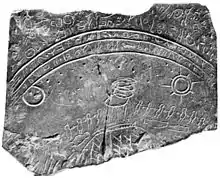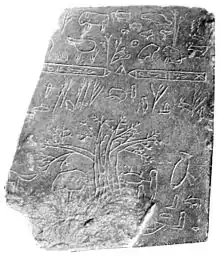Davenport Tablets
Discovery
The first two tablets were discovered on January 10, 1877 by a local clergyman, the Reverend Jacob Gass, while engaged in an emergency excavation (due to the imminent transfer of the access rights) at the site known as Cook's Farm. In an excavation a year later (the access rights having been restored), Charles Harrison, the president of the Davenport Academy of Natural Sciences, while excavating there with Gass, found a third tablet. They are often associated in discussions with a pipe found by Gass and another Lutheran minister, the Reverend Ad Blumer in 1880 in a separate group of mounds, referred to as the 'elephant pipe' by Gass. Blumer gave the pipe to the Academy and shortly after his donation, the Academy acquired a similar pipe from Gass which he reported had been found by a farmer in Louisa County, Iowa. Charles Putnam wrote a vindication of the artifacts in 1885.
Interpretations
Initially, the authenticity of the Davenport artifacts was not questioned, and even received good reviews from people like Spencer Baird, of the Smithsonian Institution, and businessman Charles E. Putnam. However, as the debate escalated from the pages of minor scholarly journals to the foremost news in the journal Science, eventually the tablets’ authenticity fell under the criticism of the new Smithsonian spokesman, Cyrus Thomas. Thomas lambasted them as “anomalous waifs,” that had absolutely no supporting, or contextual, evidence to aide in their authenticity.
University of Iowa Professor, Marshall McKusick, now refers to the find and the circumstances surrounding it as “The Davenport Conspiracy”. McKusick suggested that the tablets were modified roof tiles stolen off the Old Slate House, a house of prostitutes,[1] even though Gass described finding them in a burial mound on the Cook family farm.
McKusick suggested that the contextual ambiguity of the tablets – along with questions of Gass' honesty as an archaeologist, and even rumors of a plot by envious colleagues to plant the pseudo-artifacts in an effort to discredit and to expel the foreign-born Gass from his recently awarded post at the Davenport Academy – discredit the credibility of the Davenport Tablets.
In his 1991 book, The Davenport Conspiracy Revisited, Professor Marshall McKusick asserts that Gass may have been the victim of an ill-advised joke played on him by fellow Davenport Academy members, who were possibly motivated by their jealousy of a foreign-born outsider in their midst. In 1874 Gass had made important discoveries of beautiful and complex Native American art at the Cook farm, such as copper axes. The level of technical ability and artistic craftsmanship by ancient Native Americans was evident in these artifacts. At a time when people digging along the Mississippi River in Iowa and Illinois were turning up nothing, Gass had the luck of hitting a genuine archaeological jackpot. After that date it is questionable as to what the motives of his academic rivals and relatives were.
Another explanation for the dubious origins of the artifacts might involve the credibility of Gass himself. It is believed that Gass dealt in fake Native American effigy pipes, such as the many examples illustrated in The Davenport Conspiracy Revisited. Genuine effigy pipes are a testament to the creative abilities of the ancient Native American Indians, but their counterfeits are of poor quality. Made of shale, clay, and limestone, these frauds were often traded amongst Gass and his colleagues, many ending up in the Davenport Academy museum. However, it is possible that Gass himself was not the perpetrator of these fakes, but was again under the influence of people who were jealous of his abilities and luck in selecting excavation sites. This time though, it was his own relatives, Edwin Gass and Adolph Blumer that persuaded him to take these fakes seriously and trade them.
See also
References
- Pinsky, Randy. "The Davenport Conspiracy: Revisited and Revised". Pseudoarchaeology. Retrieved 2 December 2017.
- Putnam, Charles E. A Vindication Of The Authenticity Of The Elephant Pipes And Inscribed Tablets In The Museum Of The Davenport Academy Of Natural Sciences, 1885. ISBN 0-548-61492-X
- Guthrie, James L. "The Blind Men and the Elephants: The Davenport Relics Reconsidered." NEARA Monograph, 2005.
- Silverberg, Robert (1970). The Mound Builders. Ohio University Press. ISBN 978-0-8214-0839-1
- Williams, Stephen. Fantastic Archaeology. Philadelphia: University of Pennsylvania Press, 1991. ISBN 978-0-8122-8238-2
- McKusick, Marshall. The Davenport Conspiracy Revisited. Ames: Iowa State University Press, 1991. ISBN 978-0-8138-0344-9


